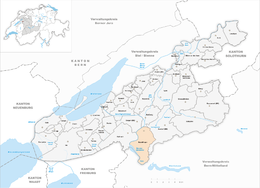Radelfingen
| Radelfingen | ||
|---|---|---|
|
||
| Coordinates: 47°1′N 7°16′E / 47.017°N 7.267°ECoordinates: 47°1′N 7°16′E / 47.017°N 7.267°E | ||
| Country | Switzerland | |
| Canton | Bern | |
| District | Seeland | |
| Area | ||
| • Total | 14.74 km2 (5.69 sq mi) | |
| Elevation | 500 m (1,600 ft) | |
| Population (Dec 2015) | ||
| • Total | 1,256 | |
| • Density | 85/km2 (220/sq mi) | |
| Postal code | 3271 | |
| SFOS number | 0309 | |
| Surrounded by | Mühleberg, Golaten, Niederried bei Kallnach, Bargen BE, Aarberg, Seedorf BE, Wohlen bei Bern | |
| Twin towns | Pobezovice (Czech Republic) | |
| Website |
www SFSO statistics |
|
Radelfingen is a municipality in the Seeland administrative district in the canton of Bern in Switzerland.
Roman coins have been found in Radelfingen and there is a Roman aqueduct in Staatswald-Gurgel. Radelfingen is first mentioned in 894 as Ratolingun in a donation made by Pirins to the Abbey of St. Gall. During the Middle Ages, the nearby Kyburg herrschaft of Oltigen and the Counts of Thierstein owned land in Radelfingen. The right to hold the low court was owned by local nobles until 1502 when Frienisberg Abbey acquired the right and gave it over to Bern. Radelfingen became part of the Bailiwick of Aarberg.
The village church was built on the site of Roman era building. The current building was built in 1594 and renovated in the 18th century. Some of the ruins of the former Cistercian Tedlingen Monastery are still visible in the village.
In 1851-52 a road was built which linked Radelfingen to Bern and Aarberg. Originally the municipality included villages on both sides of the Aare, but in 1868 the left bank of the river (including Niederruntigen, Buttenried) joined the municipality of Mühleberg. In 1906, the first Postauto in Switzerland, began service between Bern and Detligen with a stop in Radelfingen. A power plant was built in 1959-63 between Niederried and Radelfingen. During the early 20th century, the population of the villages declined as increasingly mechanized agriculture required fewer workers. However, by the 1980s, the population stabilized in Radelfingen and agriculture remained important to the local economy. In 2005, about 52% of the jobs in the municipality were in agriculture. The villages that made up the municipality originally had five schools, but by 2009 only the schools in Radelfingen village and Matzwil were still in operation.
...
Wikipedia




